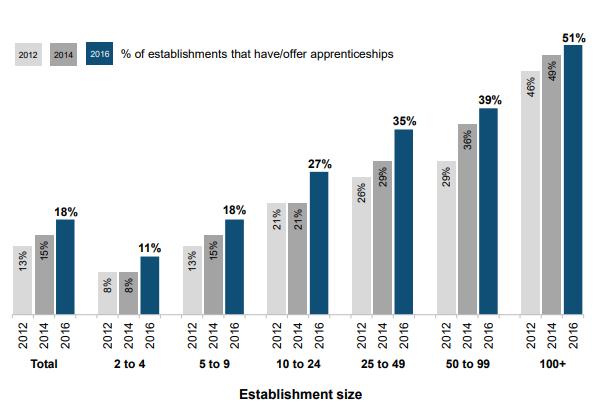Modern Apprenticeships and Small Businesses
March 2018

Federation of Small Businesses Scotland
March 2018


Foreword
This year’s Modern Apprenticeship Week is an opportunity to celebrate the success of small businesses and the apprentices they recruit. For the one in ten small businesses in Scotland recruiting apprentices (12%), they continue to be an effective way to address skills shortages and breathe new life into their workforce.
However, it is also an opportunity to reflect upon how government and industry can work together more effectively to encourage more small businesses to take on apprentices. Many small business owners rule it out as an option because they believe it isn’t right for their business, while others cannot hire apprentices due to their selfemployed status.
Naturally, not all small businesses will go down the apprenticeship route. Many of the smallest businesses often lack the formal training and recruitment processes to manage apprentices. Nonetheless, there are a range of businesses that could consider apprenticeships a viable and cost-effective way to hire staff with the right support from government.
The apprenticeship system is changing and offering employers a variety of ways to get involved. They can hire traditional Modern Apprenticeships, Foundation Apprenticeships and Graduate Apprenticeships. Much of these changes will have gone unnoticed by busy small business owners grappling with the rising costs of doing business, tighter profit margins, weak consumer demand and political uncertainties. The onus will be on Skills Development Scotland and the Scottish Government to introduce practical changes which will make it easier and less costly for small businesses looking to take on apprentices. Get the system right, in other words, and small businesses will recruit more apprentices.
This short report is certainly not the final word on small businesses and the Modern Apprenticeship system in Scotland. However, if these recommendations outlined by the Federation of Small Businesses (FSB) were introduced, we are confident that the number of small businesses taking on apprentices would increase.
Andy Willox OBE Scottish Policy ConvenorOverview
Small businesses will be key to meeting future apprenticeship targets
● Small businesses employ almost one million people in Scotland, accounting for almost half of all private sector jobs. The number of jobs in smaller businesses has grown in recent years, whilst there are fewer jobs provided by large firms.
● Since 2008, Scotland has seen more people striking out on their own and starting their own business. Last year, there were 365,000 private sector enterprises operating in the economy, the highest figure on record. The growth in selfemployment has been particularly significant, with more people earning a living through this route (258,140)1 than from the NHS in Scotland (162,700).2
● The growing importance of small businesses in the labour market means that it is vital for Skills Development Scotland (SDS), which oversees the Modern Apprenticeship system (MA), as well as training providers, to engage with small businesses.
● Further, to maintain the success of the MA system and to continue to meet Scottish Government targets (30,000 MAs per annum by 2020), it will be important for SDS to increase the pool of employers taking on apprentices.
Small businesses face a range of barriers recruiting Modern Apprentices
● The low numbers of apprentices recruited by small businesses has been a constant theme since the introduction of Scotland’s first Modern Apprenticeship programme in the 1990s.
● While the figure varies from year-to-year – in 2009, 17% of FSB members participated in the MA programme, a figure which dropped to 8% in 2013 and then increased to 12% in 2015 – the majority of small businesses choose not to recruit staff through this route according to FSB research.3
● Despite the low numbers of small businesses hiring apprentices, those that do believe it is a cost-effective way of addressing skills and labour shortages.

1 See: http://www.gov.scot/Resource/0052/00527402.pdf
2 See: http://www.gov.scot/Resource/0052/00529100.pdf
3 See: https://www.fsb.org.uk/docs/default-source/fsb-orguk/policy/rpu/scotland/assets/publi_spec_apprent_sep2009.pdf?sfvrsn=1
● The main barriers for small businesses looking to take on an apprentice, as identified by FSB research in 2009 and 2015, remain the same. These range from the direct costs of funding an apprentice and the time and costs of training, through to the lack of public funding, a perceived lack of relevance and the age restrictions on funding.
● Many of these challenges have persisted for over a decade and concerted action is now required by both the Scottish Government and SDS to tackle barriers to small business involvement in the MA system. This will be particularly important if it becomes more difficult for employers to source labour and skills from EU-27 countries following the UK’s departure from the EU.
The need for a shift in policy
● The Modern Apprenticeship system is evolving and offering employers different types of apprenticeships. These include Foundation Apprenticeships, which offer school pupils a taste of the world of work, and Graduate Apprenticeships which are industry recognised qualifications up to Master’s degree level.
● At the same time, the introduction of the UK Government’s Apprenticeship Levy, in effect a payroll tax on larger businesses, has led to the Scottish Government using the proceeds of the levy to create a Flexible Workforce Development Fund.4 The £10m fund, managed by colleges, provides up to £10,000 for each levy-paying employer to invest in workforce training.
● Although the fund has been open for less than a year, it is likely that excluding non-levy paying employers, that is the overwhelming majority of small employers, will limit the potential impact this policy will have on upskilling and reskilling workers.
● The Scottish Government should adapt the fund to enable greater numbers of small businesses to recruit apprentices, rather than offering big businesses with large training budgets small amounts of money to develop their staff.

4 See: http://www.sfc.ac.uk/publications-statistics/announcements/announcements-2017/SFCAN132017.aspx

Recommendations
FSB supports the continued investment in the Modern Apprenticeship programme but further action is required by the Scottish Government and SDS to encourage small businesses to take on apprentices.
While it is clear that the Scottish Government’s budget is under pressure, the Barnett consequentials in the next two years from the Apprenticeship Levy are £469m.5 FSB believes that this should enable additional investment in the apprenticeship system to make it more small business friendly.
1. At the height of the recession, it was important to avoid a lost generation of young people in Scotland. The apprenticeship system played its part by making it less costly to recruit and train 16-19 year olds by increasing the public sector’s contribution rate. However, while the economy continues to be in a fragile state, the labour market has improved substantially and youth unemployment rates are at record low levels.
Despite this, millennials6 have experienced an increasingly tough job market which has gone largely unnoticed by policymakers outside of gig economy circles.7 As a result, the Scottish Government should increase the contribution rates for apprentices aged 25 and over Such a move will be welcomed by small businesses given they tend to recruit older workers.8 It would also have the added bonus of simplifying the funding system for apprenticeships as has occurred in England.9
2. The cost of hiring an apprentice continues to be a key barrier preventing small businesses from participating in the scheme. While wages form only one part of the cost associated with hiring an apprentice, it is nevertheless a key constraint for small businesses who are experiencing tighter profit margins.10 As such, the Scottish Government should extend the Scottish Employer Recruitment Incentive11 to provide wage subsidies to help small businesses overcome the recruitment costs.
3. Although they account for nearly three in four of all businesses in Scotland, businesses with no employees cannot take on apprentices at the moment. This anomaly should be addressed to ensure the apprenticeship system is relevant for current and future entrepreneurs looking to expand their businesses.
5 See: https://www.gov.uk/government/news/uk-government-agrees-apprenticeship-levy-funding-deal-withdevolved-administrations
6 There is no formal definition for millennials. For the purposes of this report, they are aged between their midtwenties and mid-thirties
7 See: http://researchbriefings.parliament.uk/ResearchBriefing/Summary/CBP-7946#fullreport
8 See: https://www.fsb.org.uk/docs/default-source/Publications/micro-uptapped-fsb-report-final-101112.pdf
9 See: https://www.gov.uk/government/uploads/system/uploads/attachment_data/file/562401/Apprenticeship_funding_from _May_2017.pdf
10 See: https://www.fsb.org.uk/docs/default-source/fsb-orguk/policy/rpu/scotland/assets/publi_spec_apprent_sep2009.pdf?Status=Master&sfvrsn=1
11 See: https://www.ourskillsforce.co.uk/help-with-recruitment/our-one-stop-skills-shop/scotlands-employerrecruitment-incentive/
4. Currently SDS contract with training providers to meet their annual apprenticeships target, which remains the number one priority for SDS and the Scottish Government.12 As a result, they appear to be uninterested in the size of the business taking on apprentices. Due to the growing importance of small businesses in the economy, greater attention is required from SDS to widen the range of businesses involved in the apprenticeship system. As a first step, SDS should publish quarterly performance data broken down by business size, with a view to introducing targets for training providers
5. While there have been welcome improvements to the flagship apprenticeships website,13 it remains difficult for small businesses to find straightforward information devoid of technical jargon. Few will understand what SCQF (Scottish Credit and Qualifications Framework) levels are, for example. Therefore, SDS should create an online advisory service which contains practical, step-by-step guidance on recruiting, managing and developing apprentices.

12 See: http://www.audit-scotland.gov.uk/docs/central/2014/nr_140313_modern_apprenticeships.pdf
13 See: https://www.apprenticeships.scot/
Policy context
A Modern Apprenticeship programme, where people aged 16 and over can earn and learn on the job, has existed in some form or another in Scotland for over two decades. It is a policy every Scottish Government has invested in to deliver the country’s skills agenda, often with a focus on younger people and numerical targets. Since the SNP formed its first government in 2007, there has been a stronger focus on apprenticeships as a way to both create a skilled and educated workforce and reduce youth unemployment. This has led to a substantial increase in apprenticeship starts from 15,000 when the SNP took office14 to 26,262 in 2016-17.15
More recently, there have been further developments in the apprenticeship system including:
The introduction of a new target to deliver 30,000 apprenticeship starts by 2020.
Different types of apprenticeships available in the shape of Foundation Apprenticeships and Graduate Apprenticeships.16
A greater priority placed on higher level apprenticeships (level three and above), supporting key industries and supporting equal access to opportunities.17
These changes have also taken place at a time when the UK Government introduced the Apprenticeship Levy – a new tax that means larger employers across the UK pay 0.5% of their annual pay bill in excess of £3m, minus allowances, through the PAYE system. Although the levy was introduced without consultation with the Scottish Government, Scottish Ministers subsequently used the proceeds to create a Flexible Workforce Development Fund.18 The £10m fund, overseen by the Scottish Funding Council and managed by colleges, provides up to £10,000 for each levy-paying employer to invest in workforce training.

14 See: https://d3n8a8pro7vhmx.cloudfront.net/thesnp/pages/5540/attachments/original/1485880018/SNP_Manifesto2016web_(1).pdf?1485880018
15 See: http://www.gov.scot/Publications/2018/01/6968/0
16 See: https://www.apprenticeships.scot/take-on-an-apprentice/
17 See: https://www.skillsdevelopmentscotland.co.uk/media/44291/modern-apprenticeship-statistics-up-to-the-endof-quarter-3-2017-18-updated.pdf
18 See: http://www.sfc.ac.uk/publications-statistics/announcements/announcements-2017/SFCAN132017.aspx







